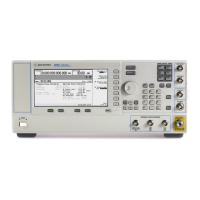278 Chapter 12
Peripheral Devices
Millimeter-Wave Source Modules
Configuring the Signal Generator
The following procedure configures a PSG for use with any external source module that has a WR
(waveguide rectangular) frequency range of 90- 140 GHz. You can modify the frequency range to
match your source module.
1. Turn on the signal generator’s line power.
NOTE Automatic leveling at the source module output is not available with the OEM Source
Module selection.
2. Press
Frequency > (3 of 3) > Source Module. Toggle the Agilent 8355x Source Module Off On softkey to Off.
3. Toggle the
OEM Source Off On softkey to On.
4. Press
OEM Source Module Config > Standard WR Freq Bands > WR8 90-140GHz.
The selections in the Standard WR Freq Bands menu are pre- defined frequency ranges and
multipliers for the most common external source module frequency ranges. They are provided for
setup convenience. If your source module has a frequency range not listed in the list of
pre- defined setups, use the
Min Band Freq, Max Band Freq, and Freq Multiplier softkeys to manually set the
range and PSG frequency display multiplier. For more information on these manual settings, refer
to the E8257D/67D PSG Signal Generators Key Reference.
5. If the RF OFF annunciator is displayed, press
RF On/Off.
To obtain flatness-corrected power, refer to “Creating and Applying User Flatness Correction” on
page 133.

